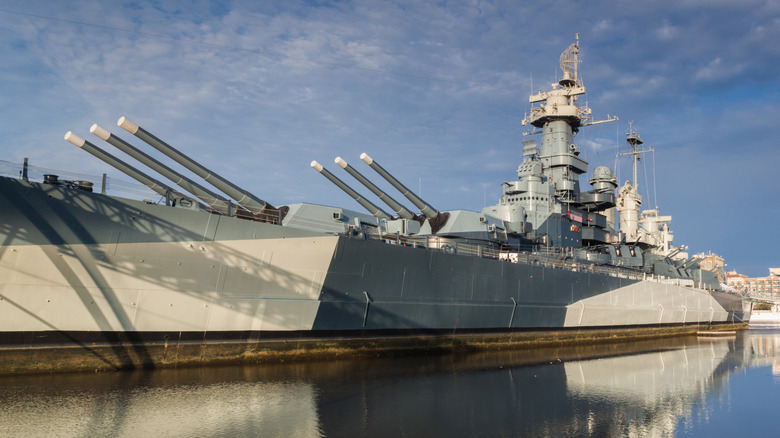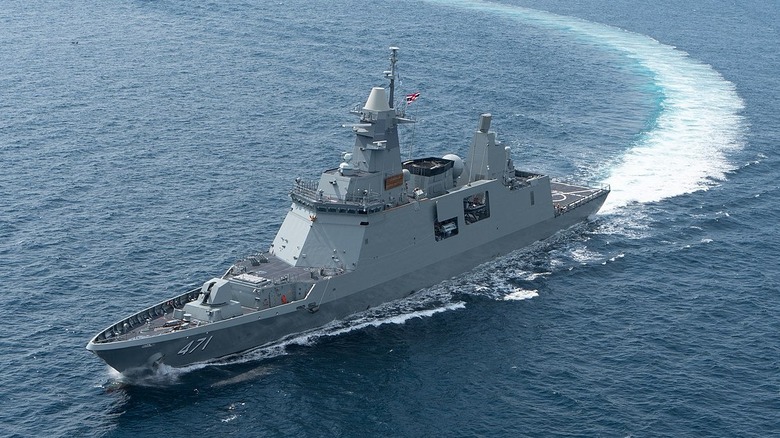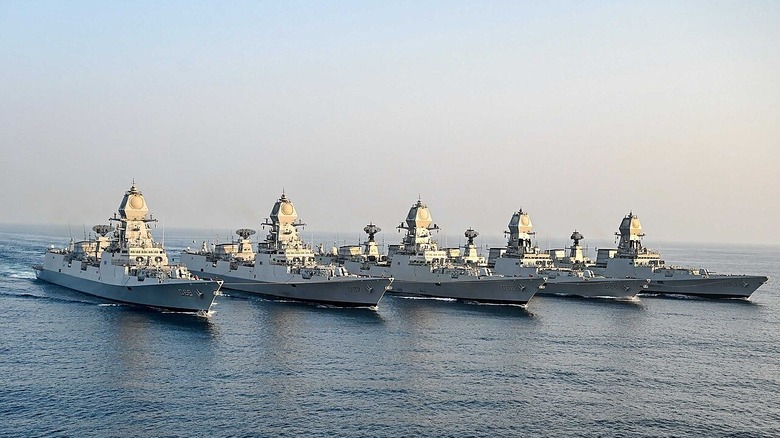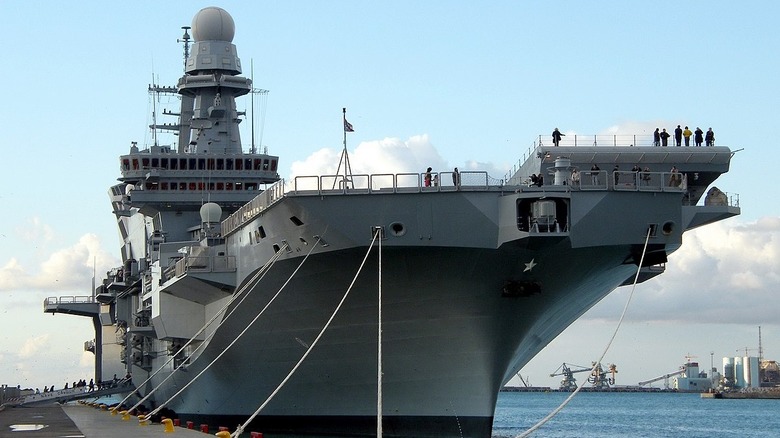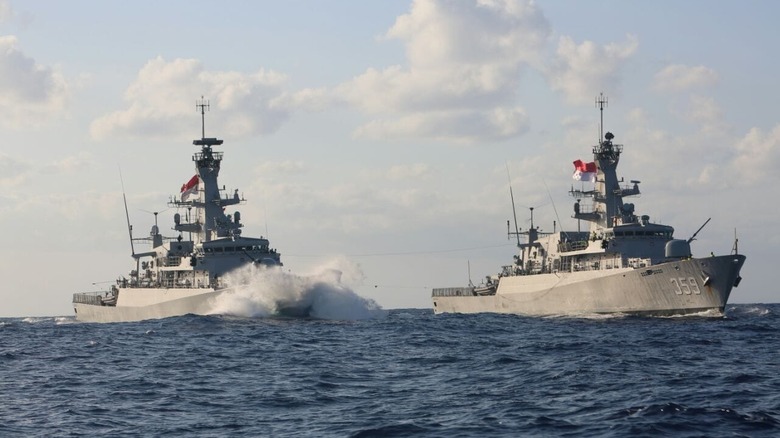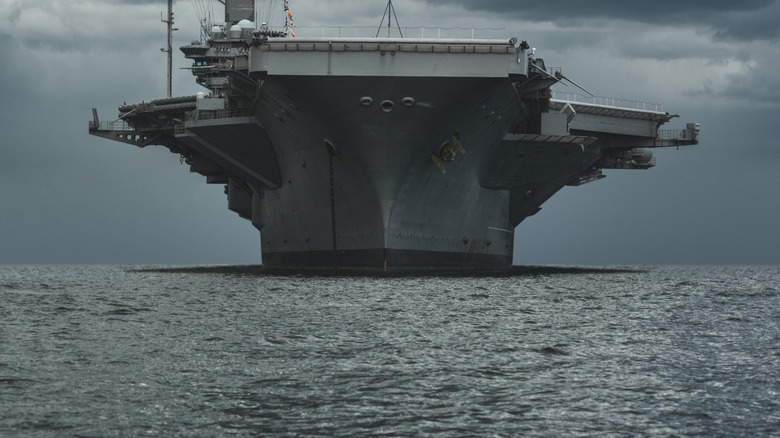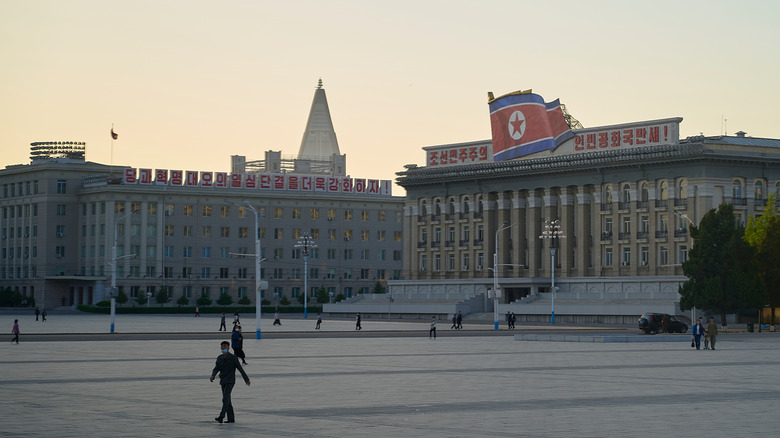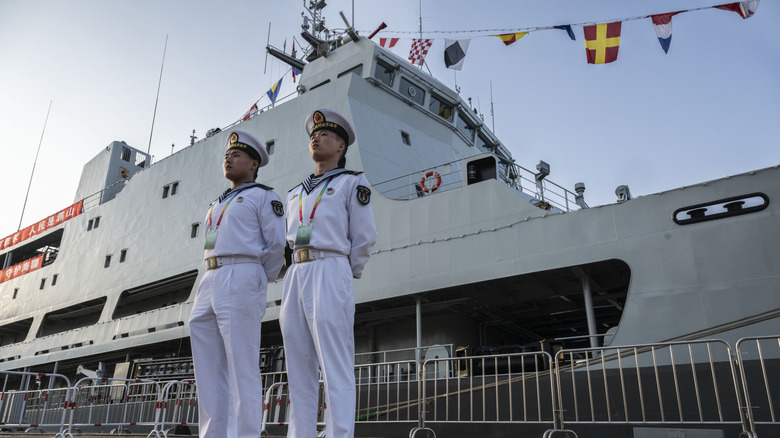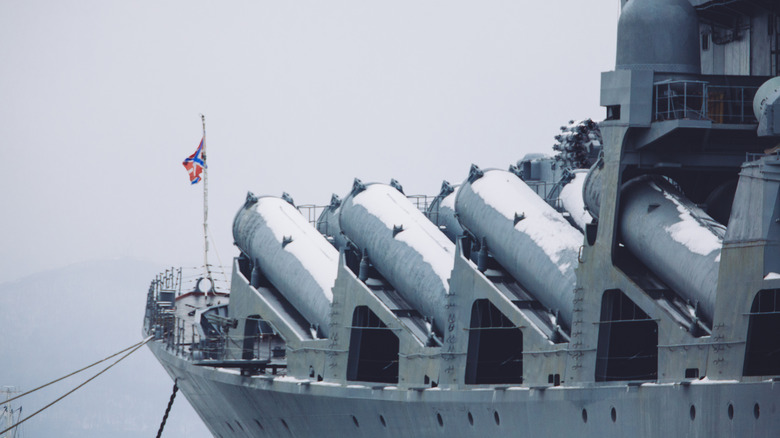10 Of The Largest Navies In The World, Ranked By Self-Reported Total Naval Assets
A nation's naval capability is directly proportional to its ability to project power worldwide. Historians sometimes describe the Mediterranean Sea as a "Roman lake" during the height of the Italian civilization's power, thanks to its ability to dominate from shore to shore. The small island nation of Britain dominated much of the globe throughout the 19th century thanks to its supremacy on the sea. Naval officer Alfred T. Mahan set the United States on a path to dominance of the waters with his 1890 book, "The Influence of Sea Power Upon History."
Modern navies are capable of much more than patrolling the seas. They are vital to securing global logistics, projecting military power, and as a bargaining chip in diplomatic negotiations. Naval power is world power, but a large navy isn't necessarily competent or even functional. In the modern era, the United States Navy is among the most powerful navies on the planet. It can launch entire invasions from battle groups organized around nuclear-powered aircraft carriers, yet it ranks fifth in size.
Quality outstrips quantity, but there is still something to be said for commanding a large naval force. Let's examine which nations field (ocean?) the largest navies— some of the positions may surprise you. We used data from the World Population Review to determine how many naval assets — not strictly warships — each navy has in its arsenal. The numbers might not make these nations the powerhouses they wish to be, but here are 10 of the largest navies in the world.
Sri Lanka — 270 ships
Starting off the top 10 is a nation located just off the coast of the Indian subcontinent. With its strategic location, Sri Lanka occupies a pivotal position nearby the many superpowers with a keen interest in the Indian Ocean Region (IOR). With a reported 270 naval assets under its command, Sri Lanka has historically focused on combating maritime terrorism, human smuggling, and drug interdiction.
In 2019, Sri Lanka announced a modernization effort under President Gotabaya Rajapaksa. Despite past economic and technological challenges, the country is determined to replace its aging fleet of patrol boats. Collaborating with Colombo Dockyard Limited, Sri Lanka is designing two classes of vessels, taking a multi-pronged approach that aims to bolster the local economy with shipbuilding projects. While fiscal problems have posed some hurdles, the potential benefits of this modernization effort are significant, offering hope for a more secure and prosperous future.
Sri Lanka still hopes to field what it calls the Twenty Ship Fleet in 2025. This fleet, a significant part of Sri Lanka's naval modernization plan, would include a pair of frigates, a pair of corvettes, and eight offshore patrol vessels, among other craft. As a relatively small island nation, Sri Lanka's best bet for security remains a robust and well-funded navy. However, carrying it to fruition may require more political and economic capital than it can muster.
Thailand — 293 ships
Thailand, another Asian nation with a unique sphere of influence, boasted a fleet of 293 naval assets in 2024. This fleet includes 70 coastal combat vessels, seven corvettes, 17 mine-laying and amphibious vessels, 13 logistical support ships, seven frigates, and an aircraft carrier. Notably, it does not count cruisers, destroyers, or submarines in its arsenal, setting it apart from other naval powers.
Thailand also stands as the only Southeast Asian nation to operate an aircraft carrier, a feat that places it amongst the most powerful in the region for force projection. The HTMS Chakri Naruebet first laid its keel in 1992, named after the Thai royal family, which has reigned in the country since the 18th century. While it technically carries helicopters, not fighters, the Chakri Narubet's role is a testament to Thailand's naval capabilities and ambitions.
Thailand's maritime strategy takes a five-pronged approach. It focuses on citizen empowerment, resource management, and expanding its knowledge and use of its waters for resource mining, community defense, and conservation. This approach underscores Thailand's commitment to not only defending its waters but also utilizing them for the benefit of its citizens and the preservation of its natural resources.
India — 294 ships
India belongs to the growing BRICS (Brazil, Russia, India, China, South Africa) economic bloc. Economic growth often goes hand in hand with military expansion, and growing its naval capabilities is a key part of that formula. India is located on the northern edge of the aptly named Indian Ocean, which has become an increasingly critical focal point of superpower interest.
The Indian Navy claimed 294 naval assets under its control in 2024. To counter Indo-Chinese interest in its region, India has engaged in an evolving maritime strategy centered on becoming a force projector rather than a coastal defender in the Indian Ocean. India's ambition to become the primary power in the Indian Ocean Region (IOR) is a clear indication of the intensity of its military goals.
In 2022, India, itself a nuclear power, commissioned the construction of a domestically built aircraft carrier in addition to growing its warship and submarine fleet. While the carrier is expected to be built at home, India has strategically reached out to France for Dassault Rafale fighter jets and Scorpene-class submarines. It has also forged significant arms deals with the United States, Israel, and Spain, demonstrating its commitment to global military alliances and its bid to expand its military.
Italy — 309
Though not an island nation like Indonesia, Italy's peninsular landmass juts into the center of a key global maritime environment in the Mediterranean Sea. World Population Review sets the Italian navy at sixth on our list, with a command of 309 naval assets under its control. While the Mediterranean might not be the Roman lake it once was, Italy still wishes to have an impact on the world's seas.
Italy belongs to the European Union, which has set a goal of mastering security and making positive impacts in the ecological realm. In an effort to meet this mandate, Italy has six patrol vessels specializing entirely in anti-pollution marine monitoring. From a military perspective, Italy is a member of the exclusive club of aircraft carrier and submarine-operating nations.
Italy currently boasts eight submarines, though none are nuclear-powered or wield nuclear weapons. Instead, its submarine fleet uses diesel-electric attack subs with ship-killing capabilities. While that technology is old when considering the evolution of the submarine and its lasting impact, eight submarines are still better than no submarines.
Italy's sole aircraft carrier, the ITS Cavour, entered service in 2009. Like the submarines, the carrier is not nuclear-powered, instead relying on four Fiat Avio LM2500 gas turbines that drive a pair of propellors. As recently as 2024, the Cavour participated in joint training operations with the United States' USS Abraham Lincoln in the Middle East.
Indonesia — 333 ships
Island nations have a special relationship with the sea. As the largest nation in the world comprised of islands, Indonesia pays special attention to its capabilities on the water. The Asian archipelago is so scattered that scientists aren't even entirely sure how many islands are in it, though the current official estimate is 17,508.
Indonesia has 333 total naval assets, putting it just a hair behind Sweden on the international stage. Though Indonesia and Sweden differ in nearly every way, both are starkly aware of an expansionary nearby power with an eye toward its territory. While Sweden contends with Russia, Indonesia's relationship with China plays a role in its naval strategy.
Thousands of scattered islands represent a unique challenge. Securing territorial waters, encouraging trade, and establishing naval sovereignty are key to Indonesia's approach to its navy. As such, it is dedicated to growing a modern navy, though its makeup may look somewhat different compared to the navies of the United States, for example.
The year 2025 marks a significant step forward for the Indonesian Navy, as it expects to take delivery from Italy of one of two offshore frigates equipped with state-of-the-art military equipment in an effort to continue modernizing and building naval power.
Sweden — 353 ships
Scandinavia enters the stage with a total of 353 naval assets under its control in 2024. While the ill-fated Vasa, which tragically sank within moments of its launch in 1628, often comes to mind when thinking of the Swedish navy, it's important to remember that Sweden's naval history is rich and diverse. The nation boasts one of the oldest continuously operating navies in history, with its inception dating back to 1522.
Sweden's strategic location, jutting into the Baltic Sea and almost touching the Danish islands, creates a narrow passage that any naval force must navigate with utmost caution to reach the Atlantic Ocean. This geographical situation is further complicated by Sweden's looming eastern neighbor — Russia. If Ukraine is any lesson, standing between Russia and its access to the open water is a high-stakes game.
Sweden's recent membership in NATO has significantly altered its strategic situation. This shift comes as NATO transitions from the land-based military thinking that dominated the early 21st century, with conflicts in the Middle East taking center stage. Sweden's substantial navy could play a pivotal role in bolstering NATO forces in the maritime sector, both in the near and distant future.
United States — 472 ships
The United States was in command of 472 total naval assets in 2024, but that may make it rank lower on this list, the capability of those assets far outstrips any other maritime force in the world. The United States Navy is not just a flotilla. It also happens to be the second-largest air force in the world (behind the United States Air Force, naturally).
Alfred T. Mahan's 1890 tome "The Influence of Sea Power Upon History" outlined the importance of a world-spanning navy, and the policymakers and politicians of the Gilded Age listened. A mere 17 years after its publication, the steamships of Theodore Roosevelt's Great White Fleet showcased its modern capabilities by circumnavigating of the globe. Since then, victories in two world wars and a Cold War have positioned the U.S. as the undisputed military superpower of the world.
A glance at the aircraft carrier fleet should explain. The U.S. operates 11 fully fledged nuclear-powered aircraft carriers and nine helicopter carriers. With a total of 20 carriers, America is the undisputed champion of force projection. China is in a distant second place with five total. Adding to this are four operational classes of nuclear submarines designed to do everything from hunt ships to rain nuclear missiles.
The United States Navy is not just a navy. It is a massive and comprehensive combined-arms platform that can field air, ground, and sea forces, including the United States Marine Corps, Navy SEALS, and a formidable air force.
North Korea — 505 ships
This one may raise some eyebrows. North Korea, known primarily for its intensely repressive regime and disheartening poverty, claims a sizable navy. We say claim because the hermit kingdom is famously tight-lipped about just about everything. However, the World Population Review indicates North Korea has as many as 505 naval assets as of 2024.
The militaristic leadership of North Korea is likely proud to boast of a sizable navy, but this is a perfect example of quantity over quality. Should a nation collect 1,000 rowboats and incorporate them into its navy, it could claim the largest in the world, based on our criteria here. The bulk of the North Korean Navy is composed of patrol and coastal vessels that putter about the peninsula nation's many miles of coastline.
North Korea has traditionally put naval power on the back burner in favor of focusing on land forces, including nuclear weaponry. The United States and Russia have long played the chess game of nuclear deterrence at sea. North Korea would love to become a player in that game. Becoming a significant nuclear power would hand North Korea more chips to play with on the international stage. Unfortunately for the nation's dynastic leadership, North Korea's technological limitations and focus on nuclear missile building have reduced its shipbuilding capabilities.
China — 730
It's no secret that China is engaged in an ambitious effort to modernize and expand its military. It is partly due to this effort that the Asian nation can boast one of the largest navies in the world. As of 2024, 730 naval assets were flying the Chinese flag.
China projects a 7.2% increase in military spending in 2025 — the same as it increased in 2024. It's naval strategy revolves around "Near Seas Defense and Far Seas Protection." In other words, it must keep the area around its considerable 9,000-plus mile coastline as safe as its far-flung military and economic assets. While the United States has primarily maintained oceanic supremacy since the end of the Second World War, China's economic and military expansionism is a rising rival to the status quo.
China's naval buildup in the previous two decades includes adding a 990-foot aircraft carrier called the Liaoning to the fleet in 2012. It launched its second carrier, the Shandong, in 2019. How many aircraft carriers each country has is a valuable hint regarding its capabilities and ambitions. China also employs three helicopter carriers, making it a reasonably powerful force in the world of naval air power.
Right now, China is primarily a power in its home waters, raising tensions and prompting a potential regional arms race. However, it is also involved in Africa and Latin America with an eye toward developing an international network of military bases, including naval ports.
Russia — 781 ships
With more than 6.6 million square miles of land within its borders, Russia is the largest nation by area on the planet. A military superpower through much of the second half of the 20th century, it should be no surprise it also has one of the largest navies in the world. According to the World Population Review, Russia controlled a total of 781 naval assets in 2024.
Despite its vast landmass and cold climate, Russia faces a unique challenge — a lack of warm-water ports that remain ice-free in winter. This geographical limitation has significantly shaped Russia's naval strategy, with a strong focus on the Black Sea. It was Catherine the Great who first secured Russia a warm-water port on the Black Sea via Crimea in 1783. This sea is Russia's gateway to the NATO-dominated Mediterranean Sea and the wider Atlantic. Centuries later, Crimea remains a pivotal point in the current geopolitical landscape. Russia undoubtedly hopes to retain control of Crimea to bolster its ability to project naval power.
However, it's become unclear how much of Russian navy is fighting fit as the behemoth's struggled to subdue Ukraine. Russia has only one aircraft carrier — the most potent weapon in any navy's arsenal since naval warfare took to the sky — but the Admiral Kuznetsov carrier hasn't seen an operational deployment since 2017, plagued by accidents and breakdowns.
While Russia's navy boasts a formidable size, modern navies demand high levels of technical proficiency and consistent maintenance. Russia may be facing challenges in this area.
Methodology
It is a matter of prudence that a nation should obfuscate the true nature, size, and capability of its military. We used World Population Review data to determine which nations deploy some of the largest navies in the world, but a large navy is not necessarily a powerful one. The fact that North Korea appears higher on this list than the United States should indicate the disparity between naval size and naval capability.
